The Effect of Anti-Armour Munitions, 1967

×
![]()
The article below is a rather straightforward translation of an essay by Captain of the Technische Dienst ir. H.K. Kroeze titled "Some comments on the effect of munitions against armour", as found under Nationaal Archief, Den Haag, Inspecties van de Wapens en Dienstvakken van de Koninklijke Landmacht, nummer toegang 2.13.158, inventarisnummer 1177.
One minor quirk of Dutch military terminology is worth pointing out here, as "anti-armour" is not necessarily the most common phrase in English. Anti-armour is the translation of tegen pantser, which as the essay itself points out, includes .50 calibre (12.7mm) and the prospective autocannon round, the 25×137mm. These rounds are certainly capable of defeating (light) armour, though not necessarily that of tanks.
A number of figures given are based on either acceptance standards or are simply quoted from manuals.
Still, some specific reports are noted, most likely indicating the results from actual testing rather than theoretical penetration.
For easier reading, STANAG 4089 figures are inserted into the text itself. In the original document, they are an annex. The images have been translated to a table as well.
Subject: Effect of munitions against armour, 13th of February 1967
Attached is an essay titled “Some comments on the effect of munitions against armour”.In the annex, armour penetration figures of weapons in use with the Koninklijke Landmacht are included.
Inspector of the Technische Dienst
Brigade-General of the Technische Staf
Ir. F. Th. Segers
Some comments on the effect of munitions against armour
ContentsI. Introduction
II. Studies
III. Evaluation of AT weapons
IV. Summary
Annex I Data on armour penetration
Annex II STANAG 4089 dated 10-5-1966
1. Introduction
The munitions for use against armour is categorized into three main types, i.e.:
a. Kinetic energy munitions (KE)
A projectile is fired at armour at great velocity.
Depending on the form, weight, material, angle of impact, and terminal velocity of the projectile, as well as the nature of the armour, the projectile can penetrate to a certain depth and thus penetrate a plate of a certain thickness.
The material of modern projectiles is tungsten carbide, or an alloy with a very high density.
Through shape (e.g. subcalibre with discarding sabot, ballistic cap, cap) ballistic characteristics and penetration are optimised as much as is possible.
The effect after penetration in the tank consists of remnants of the projectile and splinters or chunks of armour with a certain kinetic energy which can hit the crew or all sorts of internal parts of the tank.
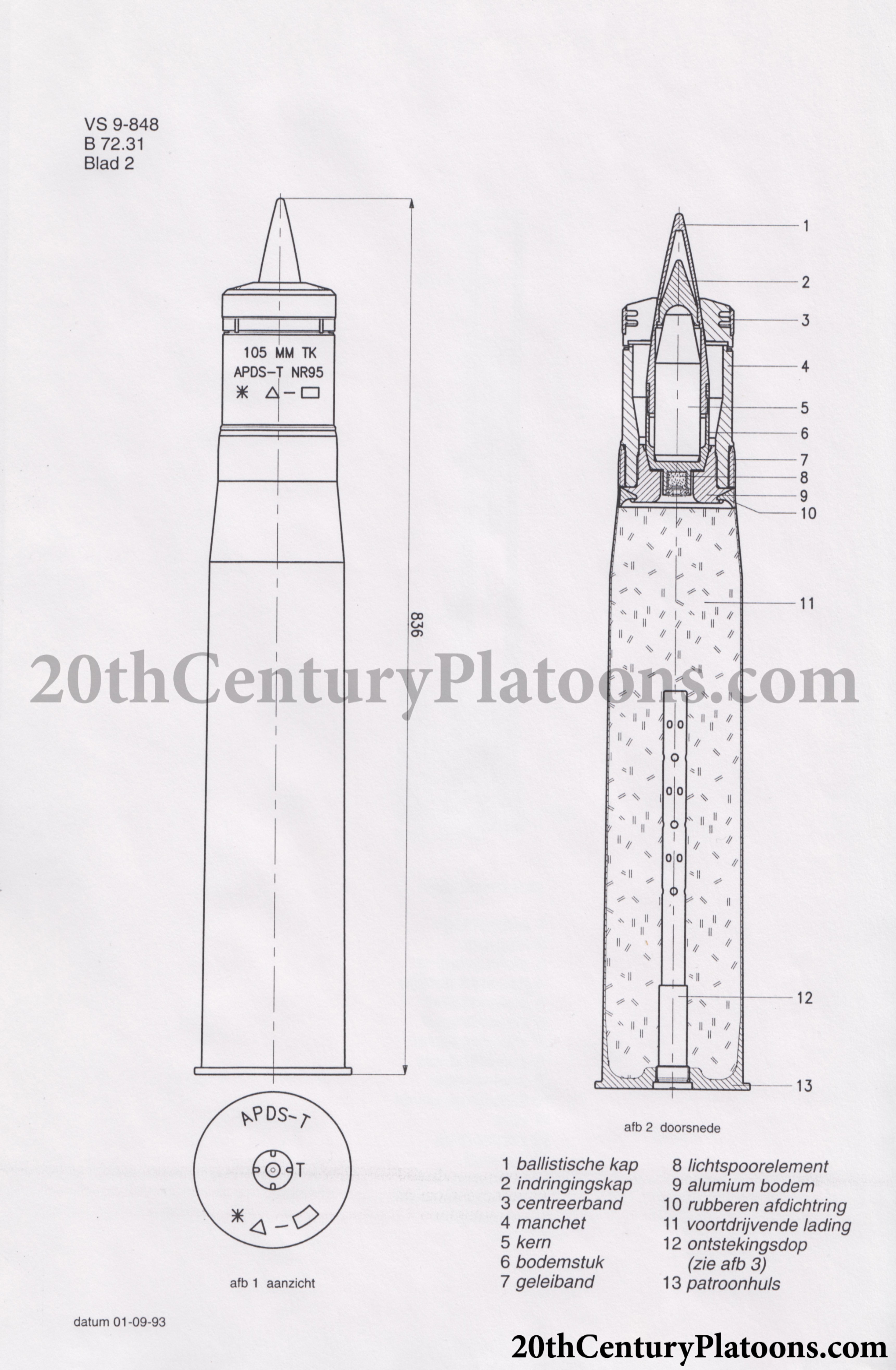
The Centurion and Leopard 1's Nr. 95 APDS, equivalent to L52A1 APDS
b. Hollow-charge munitions (HEAT = High Explosive Anti Tank)
A high-explosive grenade, of which the explosive charge is fitted at the front with a cone-shaped cavity, produces upon detonation a so-called “jet” along the axis of the cone-shaped cavity.
This “jet” is a shockwave of which the velocity can be almost twice the detonation velocity of the used explosive.
The “jet” is accompanied by a particles. These particles originate from the cone-shaped, usually copper liner with which the cavity is covered.
The “jet” exacts a great impulse upon the armour that is hit. The material flows and the shockwave with its particles penetrates a certain thickness of armour plate.
The penetration is determined especially by:
The grenade’s calibre, the form and nature of the explosive charge, distance between the explosive charge and the plate (“stand off”) and the nature of the armour (in particular the density of the material). The effect upon penetration of the tank consists of the shockwave, particles of the liner (“slug”) and particles of the armour plate. The effect is accompanied by an increase in pressure and heat.
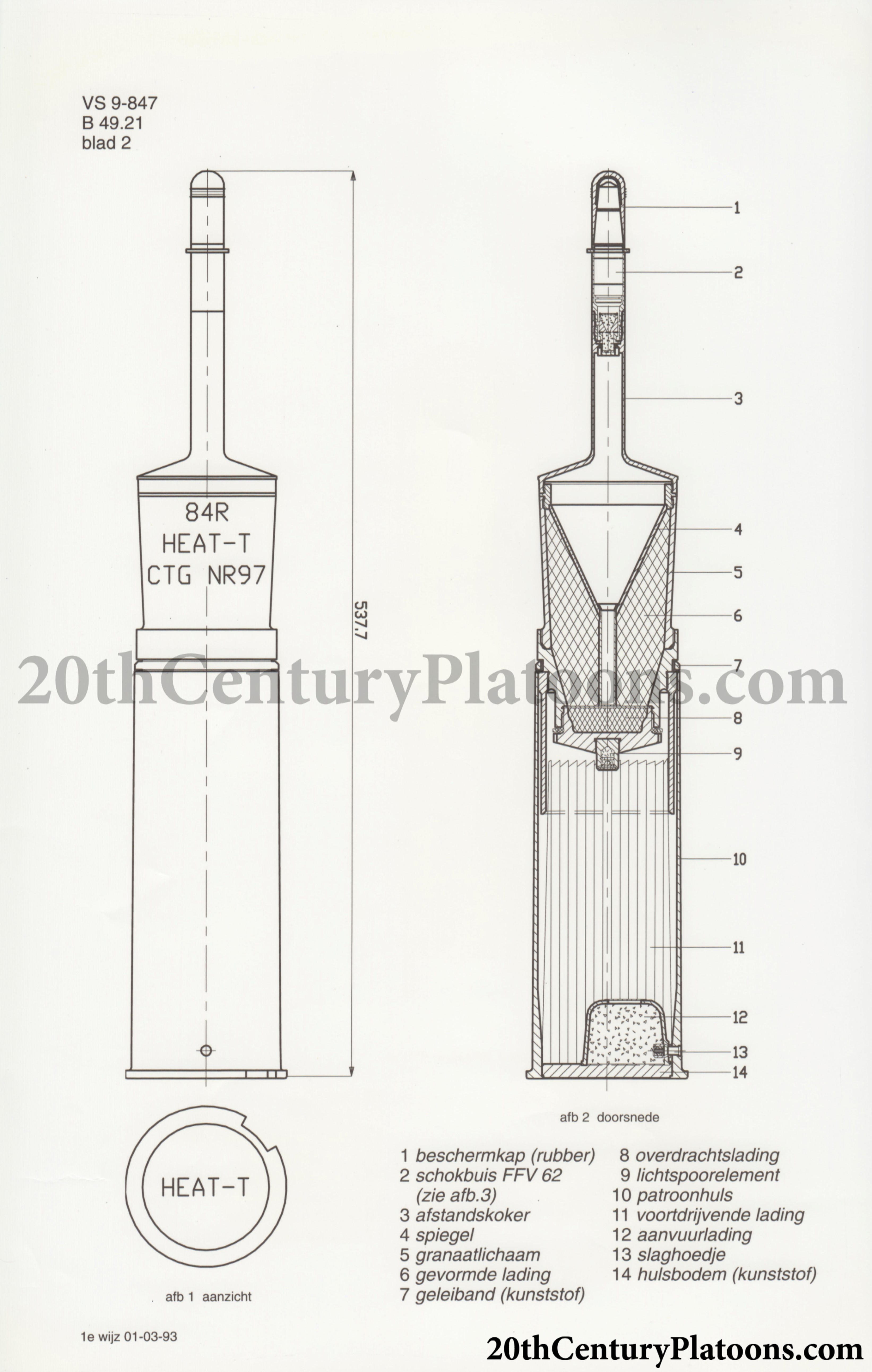
The Carl Gustav HEAT-T Nr. 97 round. Note the stand-off probe (no. 3).
c. High explosive grenade against armour (HESH = High Explosive Squash Head)
This is a thin-walled high explosive grenade, which upon impacting armour, has its explosive charge form a layer on the target, after which it detonated. Through the induced shockwave, a scab develops on the opposing side of the [armoured] plate, causing damage to the tank.
The most important factors determining the effect are the impact velocity of the grenade in combination with the delay before detonation, the nature of the explosive charge, the angle of impact, and the shape of the armour.
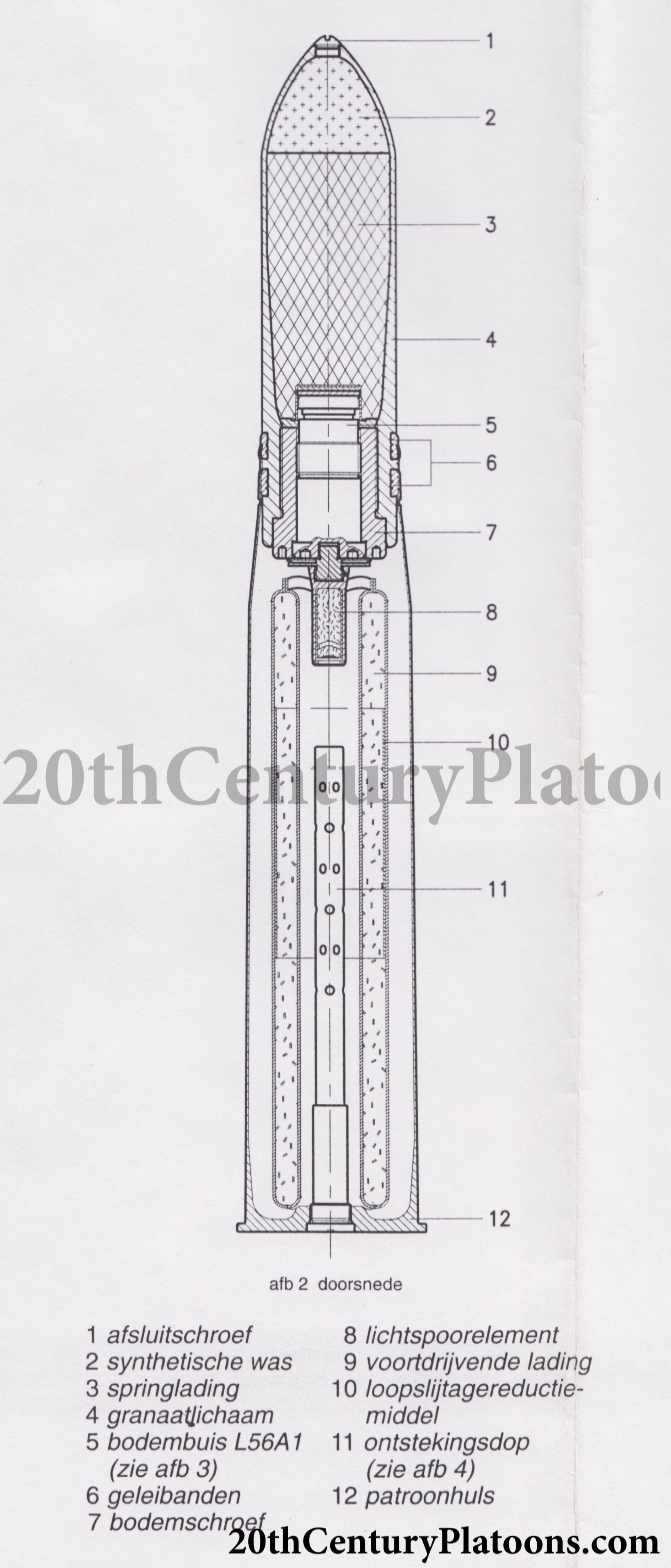
The Centurion and Leopard 1's Nr. 108 HESH, equivalent to L35A2 HESH
2. Of the munitions in use with the weapons of the Koninklijke Landmacht, data is available with regards to armour penetration.
See Annex I.
NOTE: For completeness’ sake, .50 calibre munitions and munitions for the armoured vehicle’s cannon are mentioned, although these have no effect against tanks.
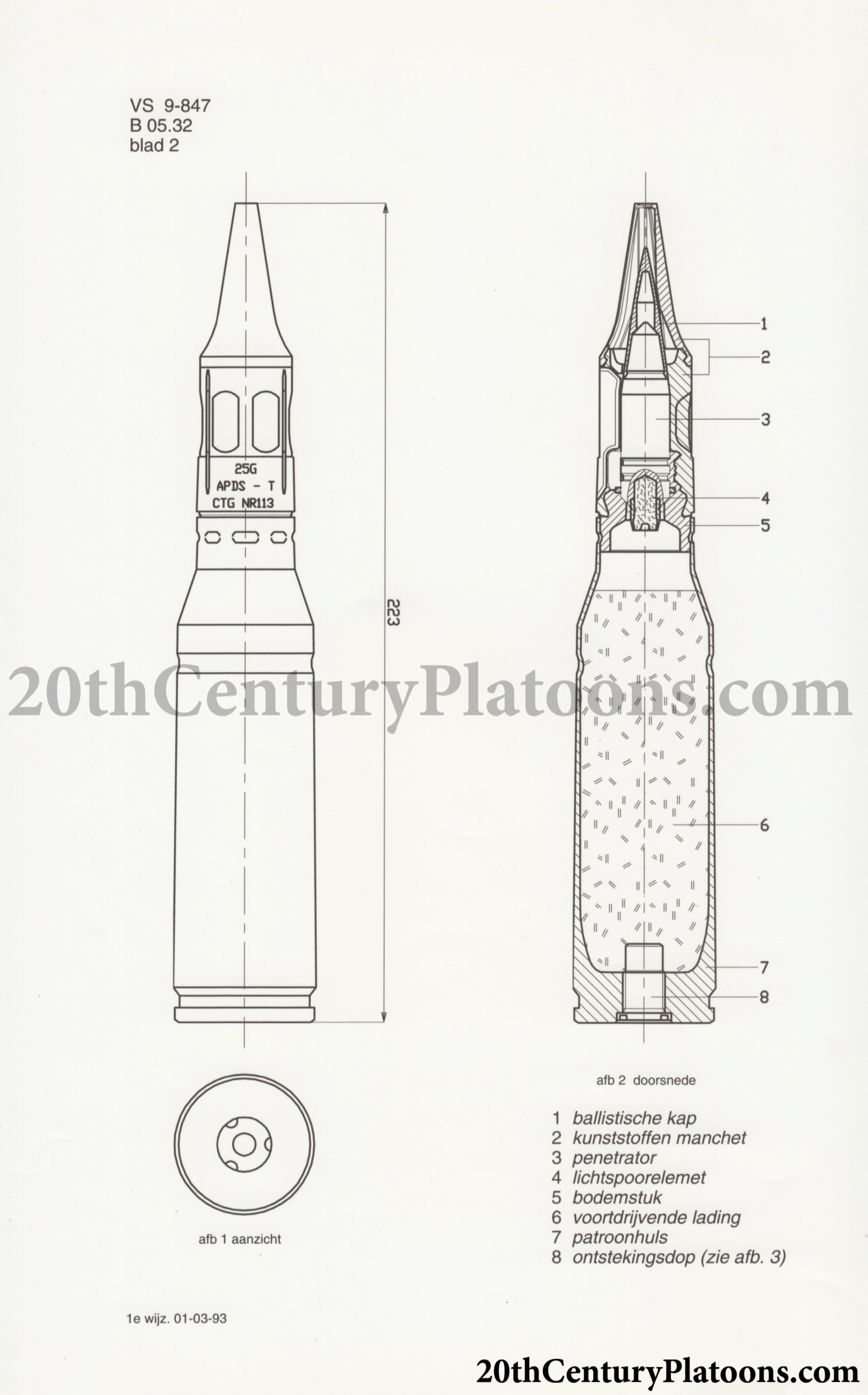
The Nr. 113 APDS as used by the M113 C&V 25mm and YPR-765 pri/prco-B
When considering the data, it must be accounted for that the data can be translated to a certain effectiveness of the munitions against tanks.
A number of factors play a role, such as :
a. The tank’s construction.
- Shape
- Armour (quality, thickness, and angles)
- Arrangement of personnel, ammunition, equipment, engine, fuel tanks etc. within the tank.
b. The impact location of the munition.
c. Angle of impact on the armoured plate.
d. For KE and HESH munitions: terminal velocity of the munition upon impact.
e. The characteristics of the munition as noted under point 1 above.
II. Studies
The effect of anti-tank munitions on armoured targets has been subject to study by various NATO-countries. There are two approaches.
1. Amongst others in Germany, fundamental research is undertaken to optimise the shaped charge. This has been reported in document AC/172-D/48.
Use is made of a barrel with pressure sensors, thermometers, and boxes filled with sand as well as paper screens (measurement of fragmentation).
A shaped charge is detonated outside of the barrel. The effect inside is registered with the equipment.
In this manner through trial and error it is possible to optimise the shaped charge (shape, liner, calibre, “stand off”, explosive, secondary explosive charge etc. are improved.
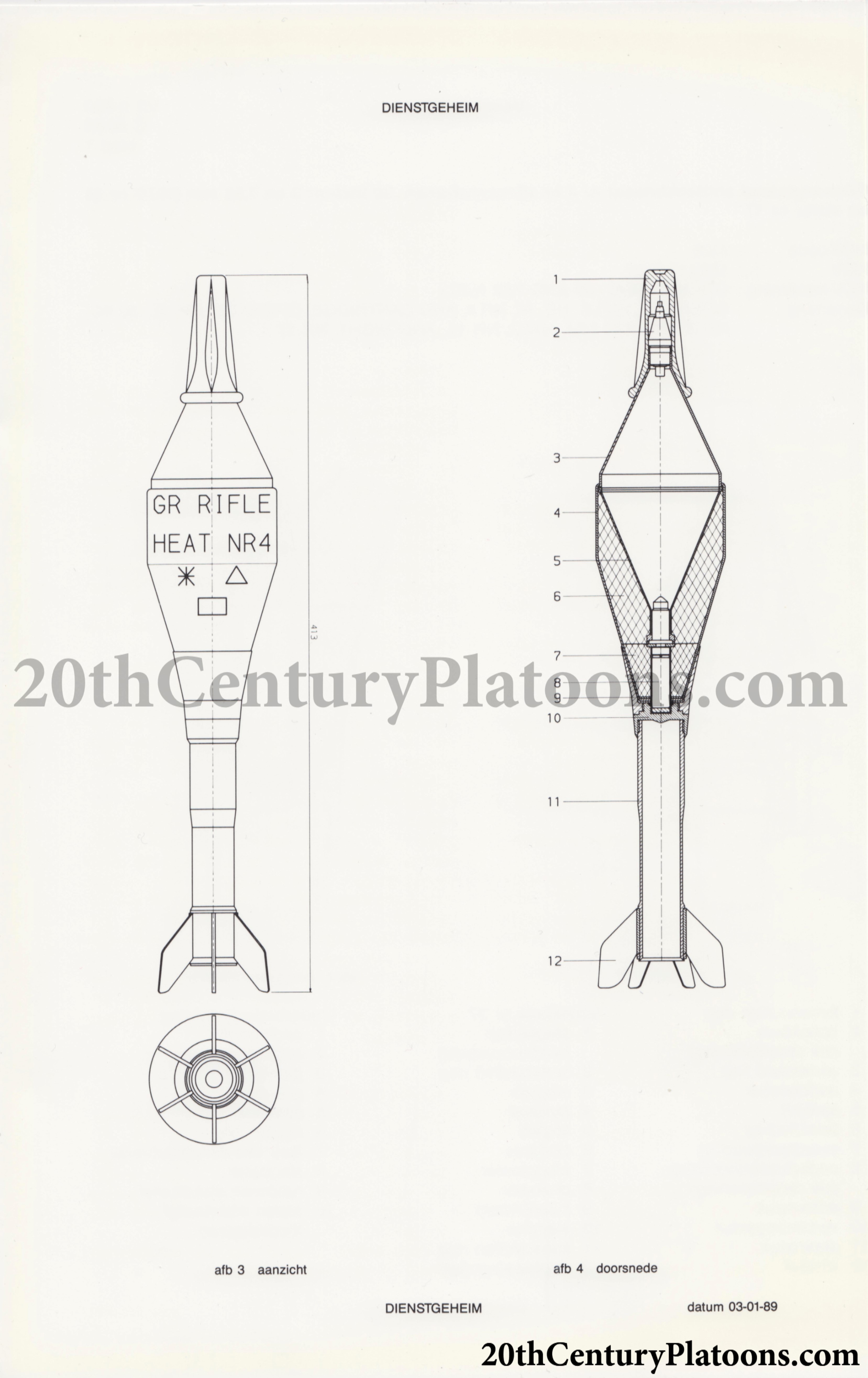
The Nr. 4 Energa HEAT rifle grenade
Example: A perforation of 300mm with a diameter of 2 cm can be notably worse than a perforation of 250mm with a diameter of 3 cm.
2. More practice-oriented research is being performed in Canada and the USA. This has been reported in documents AC/172-D/37 and AC/172 (SGAW) D/13.
In all research, an existing tank is taken as a starting point, with its surfaces divided into small sectors. Each sector represents every angle of impact for a certain rod-shaped cell of the tank. Every cell represents a cutaway of certain internal parts of the tank.
Every part of the tank is rated with a vulnerability rating, amongst others based on firing trials, with a numerical scale from 0 to 1.0. 1.0 represents complete destruction. Accounting for an expected distribution of hits on target, as well as an expected distribution of angles of impact, it is possible to rate every surface segment with a vulnerability rating through the use of a computer programme.
Furthermore, the characteristics of the munitions are noted:
For HEAT munitions: Calibre, “stand off”, penetration as a function of “stand off”, and perforation diameter as a function of “stand off”.
For KE munitions: Calibre of the round, calibre of the penetrator, velocity as a function of drag, and the ballistic limit of certain thicknesses and angles (45% penetration).
All data is used in a computer programme to generate a “kill probability” of a given impact of a given munition type.
All this is supported by static tests and firing trials.
In case a tank is taken out of action, there are 3 possibilities, i.e. a Mobility (M), Firepower (F) or Complete Kill (K).
Some data:
| HEAT | ||||
|---|---|---|---|---|
| Expected “Kill” on a IS-3 Heavy Tank | ||||
| M | F | K | M or F | |
| 76mm | 0,39 | 0,28 | 0,16 | 0,45 |
| 127mm | 0,63 | 0,39 | 0,25 | 0,68 |
| 152mm | 0,64 | 0,42 | 0,27 | 0,71 |
| 178mm | 0,66 | 0,43 | 0,29 | 0,72 |
| 203mm | 0,66 | 0,44 | 0,35 | 0,71 |
| KE | ||||||
|---|---|---|---|---|---|---|
| Current cannons | Distance m | Impact velocity m/s | Expected “Kill” on a IS-3 Heavy Tank | |||
| M | F | K | M or F | |||
| 76 AP | 0 | 973 | 0,34 | 0,16 | 0,08 | 0,4 |
| 914 | 858,5 | 0,3 | 0,14 | 0,07 | 0,35 | |
| 1829 | 747,5 | 0,25 | 0,12 | 0,05 | 0,31 | |
| 90 AP | 0 | 912 | 0,37 | 0,17 | 0,1 | 0,43 |
| 914 | 827,5 | 0,36 | 0,16 | 0,09 | 0,41 | |
| 1829 | 742 | 0,32 | 0,14 | 0,08 | 0,37 | |
| 120 AP | 0 | 1064 | 0,65 | 0,38 | 0,32 | 0,7 |
| 914 | 989,5 | 0,63 | 0,37 | 0,32 | 0,69 | |
| 1829 | 916 | 0,61 | 0,36 | 0,3 | 0,66 | |
| 105 HVAPDS | 0 | 1474 | 0,54 | 0,33 | 0,25 | 0,59 |
| 914 | 1389 | 0,53 | 0,33 | 0,24 | 0,58 | |
| 1829 | 1305 | 0,52 | 0,32 | 0,24 | 0,57 | |
Estimates for HESH munitions give worse results.
For completeness’ sake it must be noted how HESH munitions have clear advantages over KE and HEAT munitions concerning the effect on personnel, bunkers and such.
III. Evaluation of AT weapons
The evaluation of AT weapons is a valuable affair, as is clearly demonstrated in the above under point II.
In AHMWG AC 172, the following results have thus far been achieved.
1. STANAG 4089
In this STANAG, standard targets are defined, representing medium and heavy tanks, with a distinction between the turret, front, and sides.
An extract of this STANAG is visually represented in Annex II.
Firing trials against double and triple targets have up until this point rarely been undertaken. Modern munitions in general satisfy the 300mm/60° standard.
2. A sub group is concerning itself with establishing the criteria for the evaluation of anti-tank weapon systems. The firing trials on standard targets, as well as tanks, are to be defined.

STANAG 4089 Medium Tanks. Left to right, top to bottom, the targets are: turret single, front single, front double, side triple, and side triple (facultative). The single dashes represent rolled homogenous steel, the double dashes represent "soft" steel. The turret single and front single have two standards.

STANAG 4089 Heavvy Tanks. Left to right, top to bottom, the targets are: turret single, front single, front double, and side triple.
IV. Summary
The effect of anti-tank munitions is studied thoroughly in all manners.
Although many facts have been collected, a number of questions remain unanswered.
First, the problem of hitting the target is not discussed in this text. Furthermore many factors influence the result of a given hit. Amongst these factors, shape of the target is a key component.
It must be noted that double [i.e. spaced] armour, armour placed in patterns or rods of hardened steel, protrusions etc. can greatly affect the effectiveness of the munition.
A certain penetration figure can not simply be translated to a certain effectiveness against tanks.
KE munitions have a great disadvantage compared to HEAT munitions, in so far as the munition’s effect strongly depends on range. In addition, firing a KE munition requires a large and heavy weapon. The effect of HESH munitions against tanks generally lacks compared to KE and HEAT, which is related to a differing purpose in use (anti-personnel and anti-bunker and such in addition to anti-tank).
Given the many aspects of this topic, these “Comments” cannot provide an extensive study. They are merely of an exploratory nature.
‘s-Gravenhage, February 1967
The Captain of Technische Dienst
ir. H.K. Kroeze
Annex 1: Data concerning armour penetration
General: Angles of impact are stated as angles to the normal
Armour penetration data of current KE munitions
| .50 API | Source | |
|---|---|---|
| Penetrates at 100 m at 0 ° | 25mm steel | VS 9-535/1-2 [M2 Browning Manual] |
| Penetrates at 200 m at 30 ° | 19mm steel | |
| Penetrates at 400 m at 0 ° | 19mm steel | |
| Penetrates at 500 m at 30 ° | 13mm steel | |
| Penetrates at 700 m at 0 ° | 13mm steel | |
| 40mm L/60 AP-T | ||
| Penetrates at 1000m at 0° | 46mm armour | Acceptance requirement |
| 40mm L/70 AP-T | ||
| Penetrates at 130m (!) at 40° | 40mm armour | Acceptance requirement |
| Penetrates at 1000m at 0° | 60mm armour | VIM 815.02-1 |
| 20 pdr APDS-T Centurion | ||
| Penetrates at 1000m at 45° | 145mm armour | Dutch report Springfire 17-6-60 |
| Penetrates at 1000m at 60° | 95mm armour | |
| 25 pdr AP-T | ||
| Penetrates at 25m (!) at 0° | 110mm armour | |
| 105mm L7A1 APDS-T Centurion L28A1 | ||
| Penetrates at 100m (!) at 60° | 130mm armour | Report demonstration Eskmeals 27-4-65 |
| Penetrates at 1125m at 70° | 80mm armour | Q 9.066 (special) 23-3-65 |
| Penetrates at 2250m at 45° | 180mm armour | |
| Maximum impact angle 71° | ||
| 105mm L7A1 APDS-T Centurion L52A1 | ||
| Penetrates at 1000m at 45° | 200mm armour | Report Lt. Col. v. Hoytema 26-8-63 |
| Penetrates at 1110m at 70° | 80mm armour | Q 9.066 (special) 23-3-65 |
| Penetrates at 1520m at 60° | 130mm armour | |
| Penetrates at 2300m at 45° | 180mm armour | |
| Penetrates at 2000m at 65° | 10mm armour 720mm air 50mm armour |
Report demonstration 4-3-65 |
| Maximum impact angle 74° | ||
| Scabbing effect of in-use HESH munition | ||
| 105mm L7A1 HESH Centurion | ||
| At 1800m at 65° scabbing effect at 120mm armour plate | Exercise Springfire 1-6-60 | |
| Maximum impact angle 65° | ||
Armour penetration data of current HEAT munitions (calculated to 0°)
| Weapon | Penetration in armour plate in mm | Source |
|---|---|---|
| 57mm RR | 90 | TM9-1901 |
| 66mm LAW M72 | 260 | Acceptance requirement |
| 75mm Energa | 230 | Acceptance requirement |
| 75mm RR | 90 | TM9-1901 |
| 84mm Carl Gustav | 300 (maximum angle 67°) | Acceptance requirement |
| 3.5" Bazooka | 200 | TIM K/12 |
| 105mm howitser USA | 110 | Acceptance requirement |
| 105mm AMX L/30 + L/44 | 300/400 (maximum angle 79°) | Acceptance requirement/practice |
| 106mm RR | 300/400 | Acceptance requirement/practice |
| Next generation weapon for armoured vehicles |
|---|
| Required |
| Penetration of a 20mm steel plate at 1000m under 50 ° |
| Corresponds with a calibre of approx. 25mm |
Note: The above-mentioned figures are minima, as they are quite often derived from acceptance requirements. In practice, higher values can be achieved, e.g. 84mm up to 400mm, 105mm L/44 up to 400mm.
Annex 2
| STANAG 4089 10-5-66 | ||||||
|---|---|---|---|---|---|---|
| Angle | Thickness (mm) | |||||
| Medium Tank Targets | ||||||
| turret single | 0° | 250mm RHA | ||||
| 45° | 180mm RHA | |||||
| Front single | 60° | 130mm RHA | ||||
| 70° | 90mm RHA | |||||
| Front double | 60° | 40mm RHA 150mm air gap 90mm RHA |
||||
| Side triple | 65° |
10mm RHA 330mm air gap 25mm (soft steel) 330mm air gap 60mm RHA |
||||
| Side triple (facultative) | 65° | 6mm RHA 330mm air gap 25mm (soft steel) 330mm air gap 80mm RHA |
||||
| Heavy Tank Targets | ||||||
| Turret single | 0° | 300mm | ||||
| 45° | 200mm | |||||
| Front single | 60° | 150mm | ||||
| 65° | 120mm | |||||
| Front double | 60° | 40mm RHA 150mm air gap 110mm RHA |
||||
| Side triple | 65° | 10mm RHA 330mm air gap 25mm (soft steel) 330mm air gap 80mm RHA |
||||
Original document













